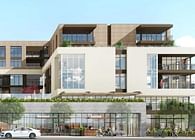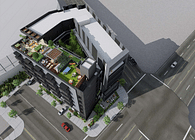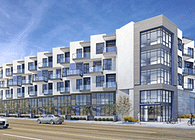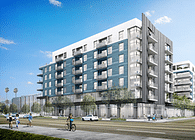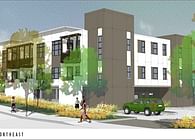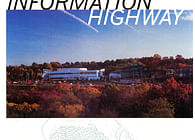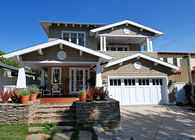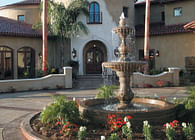
Carson Architects
BUILDING SUMMARY
This building was originally a one-story, thirty-five foot tall, 33,000 sq. ft. tilt-up concrete
structure, first used for garment storage and then as a DHL shipping facility. Our team
transformed it into a four-story 164,000 sq. ft. Self Storage Facility for StorQuest.
CHALLENGES
There were many challenges with this project:
We applied for and received a Conditional Use Permit from the City of Los Angeles
because there was a residence within five hundred feet of the site. This CUP also
granted a reduction in the required number of parking spaces for the new building.
The existing tilt-up concrete walls were saved in order to reduce the number of approvals
needed from the Planning Department. We went through a Zoning Administrative
Hearing process rather than the traditional CUP process. Salvaging most of the existing
structure saved a little bit of money on construction costs, as well as a little bit of time on
the entitlement process.
The existing building had a raised floor slab for truck deliveries that was over uncertified
fill. It was determined that the most cost effective way to deal with this problem was to
remove the existing raised slab and fill, then place the new slab at a lower level on
approved natural soil while keeping the tilt-up walls in place. Another benefit of lowering
the first floor was an increased ceiling height and eliminated the need for ramps up to the
previous finished floor height.
The existing roof needed to remain in place to provide shoring for the existing walls
during the removal and exportation of the slab and fill. An added benefit to this usage of
the existing roof was weather protection during demo and the initial stages of
construction.
The North end of the building was removed to allow access for the tractors and trucks
during the slab and fill removal. Temporary scaffolding was placed to hold up the roof
during this process.
The existing columns in the middle of the building, which supported the roof, had to
remain in place during demolition and excavation. Demo occurred around these columns
and column pads, and then temporary scaffolding was placed around each column as the
column was cut and a new piece was added. Next, footings for the extended columns
were poured at the new first floor level. Once the temporary scaffolding was removed,
the final first and second floors could be installed. After the new second floor slab was
installed, the roof could be removed. Upon roof removal, the columns were cut away and
lifted out by a crane, and the remaining holes were patched as if they were never there.
The new third and fourth floors were topped out by extending beyond the previous tilt-up
walls. We had creatively met all of the challenges presented.
Because this was a corner site, the Department of Public Works required that both
streets be made wider, some land dedicated to the city, and mandated improvements to
the sidewalks, curb, and gutter. The existing street lights, power poles, traffic signals had
to be relocated and mandatory street improvements were required by the Department of
Water and Power. The legendary DWP and Traffic Signal Division approval process
prompted the design team to meet with the public agency at the beginning of the design
phase so things would move smoothly. Even though the team was proactive and met
with DWP in the early stages of the design process, it still took the entire 12-month
construction time to get the power poles relocated and new service to the building. The
effort to meet early and often with these agencies did ultimately save some time but the
process was arduous.
The General Contractor was on top of every detail during construction and often assisted
the subcontractors in obtaining hard to find supplies. At one point, there was a shortage
of welded wire mesh for the concrete floors so they jumped into action calling suppliers
all over the Southern California. A supplier was found, the wire mesh was delivered to
the site, and the concrete floor poured on schedule. There was also a shortage of roof
insulation when the roof needed to be installed. Before an approaching weekend storm,
the contractor thought outside the box and upgraded the insulation to a higher R-value so
the roofing could be installed even though it meant that he would have to reframe all the
HVAC curbs on the roof. Once again the project remained on schedule.
THE SITE
This facility is located in an industrial neighborhood south of the central core of Los
Angeles and east of the University of Southern California. The location was attractive to
the developers because of the density of over 500,000 people within a 3-mile radius.
Due to the industrial complexion of the neighborhood, it was important that the design of
the facility elevate the personality of the area in order to attract students, downtown
residents, and business customers. The lobby on the corner of the site invites pedestrian
customers to enter off the sidewalk into an entry vestibule, and the enclosed parking
allows customers convenient access to the ground level storage, elevator lobby, and
office areas. The building opened as planned, just as the USC summer break occurred
thereby kick starting the lease up of the facility.
THE BUILDING
The exterior design is clean and modern, and the interior continues this theme through
the use of contemporary materials. The exterior pallet of metal panels, glass, and
concrete block not only provide a maintenance free exterior but also reference an urban
office building aesthetic. Building to the property lines on every side except the east
provided a maximum rentable area comprising 1,620 units. The enclosed parking area is
tall enough to accommodate moving trucks, allowing customers to load and unload under
cover in a safe environment. A mesh screen floats above a landscaped planter and
separates the parking from the sidewalk allows daylight to fill the parking area, providing
a visual connection to and from the street. The entire building is climate controlled and
the white roofing membrane reduces heat gain in the building, thereby resulting in lower
operating costs for this state of the art facility. During the design process it was
determined that it was more cost effective to climate control the entire building vs. just the
top and bottom floor. When the building is closed for business, a single switch can turn
off all the interior lights to conserve energy. At night, the glass-enclosed areas and
parking garage are illuminated to maintain safety.
THE INTERIOR
The lobby and administrative areas are designed to provide comfort and safety both to
customers and staff. The reception area is directly adjacent to the enclosed parking and
is accessible to pedestrian traffic. The outer vestibule, which is available to customers
24/7, houses a self-serve Insomniac Kiosk. Clear views from the main office and two
administrative offices to the parking areas and main entry allow a small staff to efficiently
manage the building. All floors are accessible via two elevator lobbies, one near the
office and the other off the enclosed parking area. A conference room on the corner of
the site is available to customers, creating a professional office image inside and out.
Within the lobby, there are five distinct areas: reception, waiting/lounge, customer
computer carrels, supply store, and U.S. Postal Service Unit. Customers are encouraged
to use all of these as a satellite office. The use of stone countertops, natural wood, and
contemporary carpet tiles below the floating ceiling planes give the lobby the feel of a
modern office building. Just off the lobby, a bank of sample units can be shown to new
customers displaying the different sizes of storage units.
CONCLUSION
The design and construction team, consisting of the Owner, Architect, General
Contractor, Structural Engineer, and key subcontractors, worked together during the
design and pre-construction phases to find creative solutions to the numerous
governmental and construction challenges. This storage facility was built on time and on
budget and has brought new life to an aging industrial area. In just three months, the
building has an occupancy of 18%, which is outstanding for a facility of this size.
Exceptional in every way, StorQuest Hill Street has set a new standard for urban infill
storage facilities.
Status: Built
Location: Los Angeles, CA, US
My Role: Design | Project Manager | Construction
Additional Credits: Client: StorQuest Self Storage
William Warren Properties
Architect: Carson Architects – Thomas Carson
Project Manager / Constrction: Carson Architects – John Mulcahy
Contractor: GMI Construction Services
Structural Engineer: B & B Associates, Inc.
Civil Engineer: Coory Engineering
MEP Engineer: GLP Engineering
Photos: Barry Schwartz Photography

